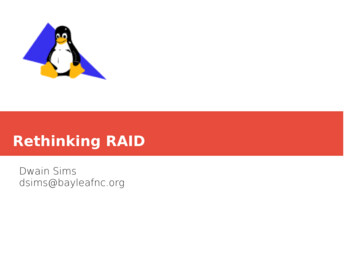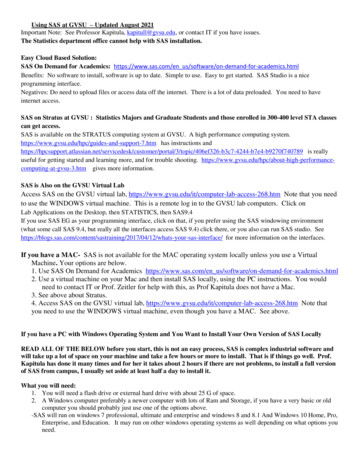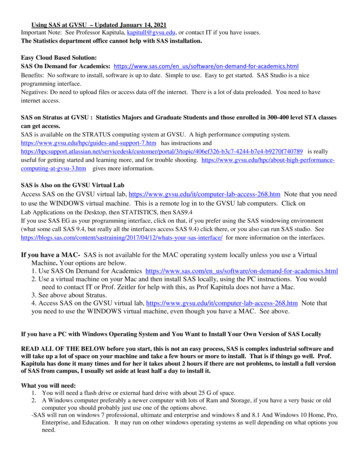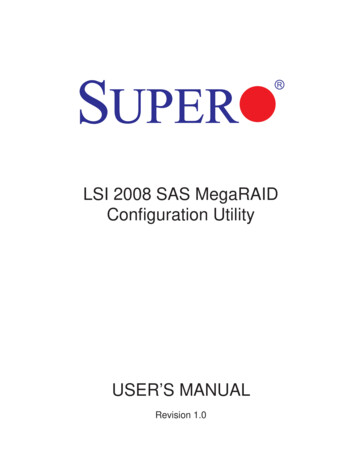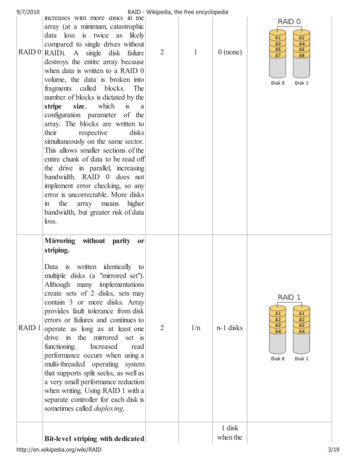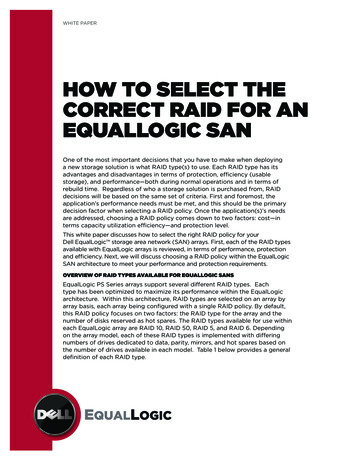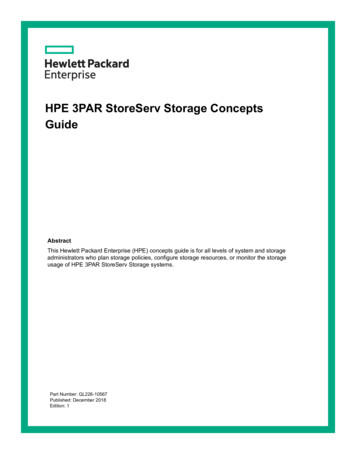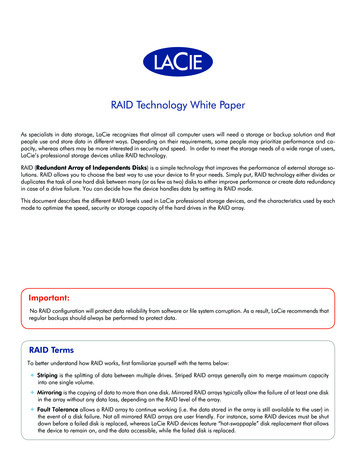
Transcription
USER’SGUIDEMegaRAID 1078-basedSAS RAID ControllersFebruary 2007 80-00157-01 Rev. A
This document contains proprietary information of LSI Logic Corporation. Theinformation contained herein is not to be used by or disclosed to third partieswithout the express written permission of an officer of LSI Logic Corporation.LSI Logic products are not intended for use in life-support appliances, devices,or systems. Use of any LSI Logic product in such applications without writtenconsent of the appropriate LSI Logic officer is prohibited.Purchase of I2C components of LSI Logic Corporation, or one of its sublicensedAssociated Companies, conveys a license under the Philips I2C Patent Rights touse these components in an I2C system, provided that the system conforms tothe I2C standard Specification as defined by Philips.Document 80-00157-01 Rev. A, February 2007. This document describes thecurrent versions of the LSI Logic Corporation MegaRAID SAS RAID controllersand will remain the official reference source for all revisions/releases of theseproducts until rescinded by an update.LSI Logic Corporation reserves the right to make changes to any products hereinat any time without notice. LSI Logic does not assume any responsibility orliability arising out of the application or use of any product described herein,except as expressly agreed to in writing by LSI Logic; nor does the purchase oruse of a product from LSI Logic convey a license under any patent rights,copyrights, trademark rights, or any other of the intellectual property rights ofLSI Logic or third parties.Copyright 2007 by LSI Logic Corporation. All rights reserved.TRADEMARK ACKNOWLEDGMENTLSI Logic, the LSI Logic logo design, Fusion-MPT, and MegaRAID aretrademarks or registered trademarks of LSI Logic Corporation. Microsoft andWindows are registered trademarks of Microsoft Corporation. SUSE is atrademark and NetWare is a registered trademark of Novell, Inc. Red Hat is aregistered trademark of Red Hat, Inc. UnixWare is a registered trademark ofThe Open Group. OpenServer is a trademark of Caldera International, Inc. Linuxis a registered trademark of Linus Torvalds. All other brand and product namesmay be trademarks of their respective companies.To receive product literature, visit us at http://www.lsi.com.For a current list of our distributors, sales offices, and design resourcecenters, view our web page located t 2007 by LSI Logic Corporation. All rights reserved.
PrefaceThis document is the primary reference and user’s guide for the LSILogic MegaRAID Serial Attached SCSI/SATA II RAID Controllers basedon the LSISAS1078, which is a SAS/SATA RAID On-a-Chip device. Itcontains complete installation instructions for these RAID controllers andincludes specifications for them.The MegaRAID 1078-based Serial Attached SCSI (SAS) RAID controllerfamily consists of the following controllers: MegaRAID SAS 8704ELP PCI Express Low-Profile Serial-AttachedSCSI/SATA II Disk Array Controller with Internal Connectors MegaRAID SAS 8708ELP PCI Express Low-Profile Serial-AttachedSCSI/SATA II Disk Array Controller with Internal Connectors MegaRAID SAS 8888ELP PCI Express Low-Profile Serial-AttachedSCSI/SATA II Disk Array Controller with External Connectors andInternal ConnectorsFor details on how to configure the RAID controllers, refer to theMegaRAID SAS Software User’s Guide. For information about theoperating system drivers, refer to the MegaRAID SAS Device DriverInstallation User’s Guide.AudienceThis document assumes that you have some familiarity with RAIDcontrollers and related support devices. The people who benefit from thisbook are: Engineers who are designing a system that will include a MegaRAID1078-based SAS RAID controller Anyone who is installing a MegaRAID 1078-based SAS RAIDcontroller in a RAID systemMegaRAID 1078-based SAS RAID Controllers User’s GuideCopyright 2007 by LSI Logic Corporation. All rights reserved.iii
OrganizationThis document contains the following chapters and appendix: Chapter 1, Overview, provides an overview of the MegaRAID 1078based SAS RAID controllers. Chapter 2, MegaRAID SAS Hardware Installation, describes theprocedures for installing the MegaRAID 1078-based SAS RAIDcontrollers. Chapter 3, MegaRAID SAS RAID Controller Characteristics,provides the characteristics and technical specifications for theMegaRAID 1078-based SAS RAID controllers. Appendix A, Glossary of Terms and Abbreviations, lists anddefines the terms and abbreviations used in this document.Related PublicationsMegaRAID SAS Device Driver Installation User’s GuideDocument Number: 80-00163-01 Rev. AThis document describes how to install the MegaRAID device driver foryour operating system. The information in this document is independentof the back-end bus and applies to the MegaRAID SAS RAID controllers.MegaRAID SAS Software User’s GuideDocument Number: 80-00156-01 Rev. AThis document describes how to use the MegaRAID Storage Manager,WebBIOS, and command line interface (CLI) utilities to configure,monitor, and maintain MegaRAID SAS RAID controllers and thestorage-related devices connected to them.Intelligent Battery Backup Units for 1078-based MegaRAID ProductsUser’s GuideDocument Number: 80-00162-01 Rev. AThis document describes how to install and use the LSI Logic batterybackup units for MegaRAID 1078-based SAS RAID controllers. The1078-based SAS boards use the LSI Logic intelligent Battery BackupivPrefaceCopyright 2007 by LSI Logic Corporation. All rights reserved.
Unit 01 (LSIiBBU01), the LSI Logic intelligent Battery Backup Unit 05(LSIiBBU05), and the LSI Logic intelligent Transportable Battery BackupUnit 03 (LSIiTBBU03).ConventionsThe following table describes how the user interacts with the product::NotationExampleMeaning and UseCourier typeface.nwk fileNames of commands, files, and directories, as well ascode and screen messages, are shown in Courier.Bold typefacefd1spIn a command line, keywords are shown in bold, non-italictypeface. Enter them exactly as shown.ItalicsmoduleIn command lines and names, italics indicate user variables. Replace italicized text with appropriate userspecified items. Enter items of the type called for, usinglowercase.Initial capital lettersUndoEditApplyNames of menu commands, options, check buttons, textbuttons, options buttons, text boxes, list boxes, and so on.,are shown in text with Initial Capital lettering to avoid misreading. These elements might appear on your screen inall lowercase.Semicolon, and otherpunctuationUse as shown in the text.Note:Caution:Notes contain supplementary information that can affectsystem performance.Cautions are notifications that an action has the potential toadversely affect equipment operation, system performance,or data integrity.Revision HistoryDocument Number Date/VersionRemarks80-00157-01 Rev. A February 2007Initial release of the document.PrefaceCopyright 2007 by LSI Logic Corporation. All rights reserved.v
Safety InstructionsUse the following safety guidelines to help protect your computer systemfrom potential damage and to ensure your own personal safety.Note:Use the MegaRAID 1078-based SAS RAID controllerswith UL-listed Information Technology Equipment (ITE)products only.When Using Your Computer System – As you use your computersystem, observe the following safety guidelines:Caution: viDo not operate your computer system with any covers(such as computer covers, bezels, filler brackets, andfront-panel inserts) removed.To avoid damaging your computer, make sure that the voltageselection switch on the power supply is set to match the alternatingcurrent (AC) power available at your location:–115 volts (V)/60 hertz (Hz) in most of North American and SouthAmerican countries, and some Far Eastern countries, such asJapan, South Korea, and Taiwan.–230 V/50 Hz in most of Europe, the Middle East, and the Far East.Also make sure that your monitor and attached peripherals areelectrically rated to operate with the AC power available in yourlocation. To avoid possible damage to the system board, wait 5 seconds afteryou turn off the system before you remove a component from thesystem board or disconnect a peripheral device from the computer. To prevent electric shock, connect the computer and peripheralpower cords into correctly grounded power sources. These cords areequipped with three-prong plugs to ensure correct grounding. Do not use adapter plugs or remove the grounding prong from acable. If you must use an extension cable, use a three-wire cablewith correctly grounded plugs. To protect your computer system from sudden, transient increasesand decreases in electrical power, use a surge suppressor, lineconditioner, or uninterruptible power supply (UPS).PrefaceCopyright 2007 by LSI Logic Corporation. All rights reserved.
Make sure that equipment does not rest on your computer systemcables and that the cables are not located where they can bestepped on or tripped over. Do not spill food or liquids on your computer. If the computer getswet, consult the documentation that came with it. Do not push any objects into the openings of your computer. Doing socan cause fire or electric shock by shorting out interior components. Keep your computer away from radiators and heat sources. Also, donot block cooling vents. Avoid placing loose papers underneath yourcomputer; do not place your computer in a closed-in wall unit or ona rug.When Working Inside Your Computer –Caution:Do not attempt to service the computer system yourself,except as explained in this document and elsewhere inLSI Logic documentation. Always follow installation andservice instructions closely.1. Turn off your computer and any peripherals.2. Disconnect your computer and peripherals from their power sources.Also disconnect any telephone or telecommunications lines fromthe computer.Performing these actions reduces the potential for personal injury orshock.Also note these safety guidelines: When you disconnect a cable, pull on its connector or on itsstrain-relief loop, not on the cable itself. Some cables have aconnector with locking tabs. If you are disconnecting this type ofcable, press in on the locking tabs before you disconnect the cable.As you pull connectors apart, keep them evenly aligned to avoidbending any connector pins. Also, before you connect a cable, makesure that both connectors are correctly oriented and aligned. Handle components and cards with care. Do not touch thecomponents or contacts on a card. Hold a card by its edges or by itsmetal mounting bracket. Hold a component, such as amicroprocessor chip, by its edges, not by its pins.PrefaceCopyright 2007 by LSI Logic Corporation. All rights reserved.vii
Protecting Against Electrostatic Discharge – Static electricity canharm delicate components inside your computer. To prevent staticdamage, discharge static electricity from your body before you touch anyof your computer’s electronic components, such as the microprocessor.To discharge static electricity, touch an unpainted metal surface, such asthe metal around the card-slot openings at the back of the computer.As you continue to work inside the computer, periodically touch anunpainted metal surface to remove any static charge your body may haveaccumulated. In addition to the preceding precautions, you can also takethe following steps to prevent damage from electrostatic discharge:viii When unpacking a static-sensitive component from its shippingcarton, do not remove the component from the antistatic packingmaterial until you are ready to install the component in yourcomputer. Just before unwrapping the antistatic packaging, be sureto discharge static electricity from your body. When transporting a sensitive component, first place it in anantistatic container or packaging. Handle all sensitive components in a static-safe area. If possible, useantistatic floor pads and workbench pads.PrefaceCopyright 2007 by LSI Logic Corporation. All rights reserved.
ContentsChapter 1Overview1.11.21.31.41.51.61.71.8OverviewSAS Controller DescriptionsGeneral DescriptionConfiguration ScenariosBenefits of the SAS Interface1.5.1PCI Express Architecture1.5.2Operating System SupportSummary of SAS RAID Controller Characteristics1.6.1SAS Features1.6.2SAS Array Limitations1.6.3SATA II Features1.6.4PCI Express Performance1.6.5Usability Features1.6.6Flexibility Features1.6.7Drive Roaming1.6.8Drive MigrationHardware SpecificationsTechnical SupportChapter 2MegaRAID SAS Hardware Installation2.1Requirements2.2Quick Installation2.3Detailed InstallationMegaRAID 1078-based SAS RAID Controllers User’s GuideCopyright 2007 by LSI Logic Corporation. All rights 121-121-121-131-151-162-12-22-2ix
2.42.52.6SAS Device Cables2.4.1Connecting the SAS RAID Controllerwith External Connectors to Drive Boxesand Drive Enclosures2.4.2Connecting the SAS RAID Controller withInternal Connectors to Physical DisksReplacing a Failed Controller Containing Data inthe LSIiTBBU03After Installing the RAID ControllerChapter 3MegaRAID SAS RAID Controller Characteristics3.1MegaRAID 1078-based SAS RAID Controller Family3.1.1MegaRAID SAS 8704ELP/8708ELPRAID Controllers3.1.2MegaRAID SAS 8888ELP RAID Controller3.2MegaRAID SAS 1078-based RAID ControllerCharacteristics3.3Technical Specifications3.3.1RAID Controller Specifications3.3.2Array Performance Features3.3.3Fault Tolerance3.3.4Electrical CharacteristicsPower Supply Requirements for the SAS8704ELP and SAS 8708ELP RAID ControllersPower Supply Requirements for theSAS 8888ELP RAID Controller3.3.5Operating and Non-operating Conditions3.3.6Safety CharacteristicsAppendix AGlossary of Termsand AbbreviationsCustomer FeedbackxContentsCopyright 2007 by LSI Logic Corporation. All rights 113-123-123-133-133-14
Figures1.11.22.12.22.32.42.52.63.13.2Example of an LSI Logic SAS Direct-Connect ApplicationExample of an LSI Logic SAS RAID ControllerConfigured with an LSISASx12 ExpanderExample of the MegaRAID SAS 8708ELP BoardInstallation in a PCI Express SlotInternal SAS Cable for Connection to SAS PhysicalDisks, SATA II Physical Disks, or BothSATA II ConnectorsSAS and SATA II Plugs and SAS BackplaneReceptacle ConnectorConnecting the SAS 8888E RAID Controllerwith External Connectors to a Drive Box orDrive EnclosureConnecting a SAS 8708ELP RAID Controllerwith Internal Connectors to Physical DisksCard Layout for the MegaRAID SAS 8708ELPRAID ControllerCard Layout for the MegaRAID SAS 8888ELPRAID ControllerContentsCopyright 2007 by LSI Logic Corporation. All rights reserved.1-61-62-42-62-72-82-92-103-23-5xi
xiiContentsCopyright 2007 by LSI Logic Corporation. All rights reserved.
Tables1.11.23.13.23.33.43.53.63.73.8SAS RAID Controller Array LimitationsMegaRAID 1078-based SAS RAID ControllerComparisonsSAS 8708ELP RAID Controller – Jumpersand ConnectorsSAS 8888ELP RAID Controller – Jumpers andConnectorsMegaRAID 1078-based SAS RAID controllerCharacteristicsRAID Controller SpecificationsArray Performance FeaturesFault Tolerance FeaturesPower Supply for the SAS 8704ELP and theSAS 8708ELP RAID ControllersPower States for the SAS 8888ELP RAID ControllerContentsCopyright 2007 by LSI Logic Corporation. All rights reserved.1-101-153-33-53-73-83-103-113-123-13xiii
xivContentsCopyright 2007 by LSI Logic Corporation. All rights reserved.
Chapter 1OverviewThis chapter provides an overview of the MegaRAID 1078-based SerialAttached SCSI/Serial ATA II controllers with RAID control capabilities. Itconsists of the following sections:1.1 Section 1.1, “Overview” Section 1.2, “SAS Controller Descriptions” Section 1.3, “General Description” Section 1.4, “Configuration Scenarios” Section 1.5, “Benefits of the SAS Interface” Section 1.6, “Summary of SAS RAID Controller Characteristics” Section 1.7, “Hardware Specifications” Section 1.8, “Technical Support”OverviewThe MegaRAID 1078-based SAS RAID controllers are high-performanceintelligent PCI Express-to-SCSI/Serial ATA II adapters with RAID controlcapabilities. MegaRAID 1078-based SAS RAID controllers providereliability, high performance, and fault-tolerant disk subsystemmanagement. They are an ideal RAID solution for the internal storage ofworkgroup, departmental, and enterprise systems. MegaRAID 1078based SAS RAID controllers offer a cost-effective way to implementRAID in a server.SAS technology brings a wealth of options and flexibility with the use ofSAS and Serial ATA (SATA) II devices within the same storageinfrastructure. However, SAS and SATA devices bring individualcharacteristics that make each one a more suitable choice depending onyour storage needs. MegaRAID gives you the flexibility to combine theseMegaRAID 1078-based SAS RAID Controllers User’s GuideCopyright 2007 by LSI Logic Corporation. All rights reserved.1-1
two similar technologies on the same controller, within the sameenclosure, and in the same virtual disk.Note:LSI Logic recommends that you carefully assess anydecision to mix SAS and SATA drives within the samevirtual disks. Although you can mix drives, LSI stronglydiscourages the practice.The MegaRAID 1078-based SAS RAID controllers are based on the LSILogic first-to-market SAS IC technology and proven MegaRAIDtechnology. As second-generation PCI Express RAID controllers, theMegaRAID SAS RAID controllers address the growing demand forincreased data throughput and scalability requirements across midrangeand enterprise-class server platforms. LSI Logic offers a family ofMegaRAID SAS RAID controllers addressing the needs for both internaland external solutions.The following battery backup units provide cached data protection andallow system builders to protect cached data even during the mostcatastrophic system failures: LSI Logic intelligent Battery Backup Unit 01 (LSIiBBU-01) LSI Logic intelligent Battery Backup Unit 05 (LSIiBBU-05) LSI Logic intelligent Transportable Battery Backup Unit 03(LSIiTBBU-03)Refer to the MegaRAID Battery Backup Unit User’s Guide on theMegaRAID Universal Software Suite CD for more information aboutthese batteries.The SAS controllers support the ANSI Serial Attached SCSI standard,version 1.1. In addition, the controller supports the SATA II protocoldefined by the Serial ATA specification, version 1.0a. Supporting both theSAS and SATA II interfaces, the SAS controller is a versatile controllerthat provides the backbone of both server and high-end workstationenvironments.Each port on the SAS RAID controller supports SAS devices, SATA IIdevices, or both, using the following protocols: 1-2SAS Serial SCSI Protocol (SSP), which enables communication withother SAS devicesOverviewCopyright 2007 by LSI Logic Corporation. All rights reserved.
1.2 SATA II, which enables communication with other SATA II devices Serial Management Protocol (SMP), which communicatestopology management information directly with an attached SASexpander device Serial Tunneling Protocol (STP), which enables communication witha SATA II device through an attached expanderSAS Controller DescriptionsThe 1078-based SAS RAID controllers are described as follows:1.3 The MegaRAID SAS 8704ELP PCI Express 1078-based Low-ProfileSerial-Attached SCSI/SATA II Disk Array Controller controls fourinternal SAS/SATA ports through one Mini SAS 4i internal connector. The MegaRAID SAS 8708ELP PCI Express 1078-based Low-ProfileSerial-Attached SCSI/SATA II Disk Array Controller controls eightinternal SAS/SATA ports through two Mini SAS 4i internal connectors The MegaRAID SAS 8888ELP PCI Express 1078-based Low-ProfileDisk Array RAID Controller has one I/O processor. This processorcontrols eight ports through two (x4 SAS Port) SFF-8088 Mini SAS4i external connectors and two (x4 SAS Port) SFF-8087 Mini SAS 4iinternal connectors, configurable through a SAS mux.General DescriptionThe MegaRAID 1078-based SAS RAID controllers bring 3.0 Gbit/s SerialAttached SCSI and 3.0 Gbit/s SATA II performance to host adapter,workstation, and server designs. The controllers support internal andexternal storage devices, which allow you to use a system that supportsenterprise-class SAS drives and desktop-class SATA II drives. EachMegaRAID 1078-based SAS RAID controller can connect to drivesdirectly and can use expanders to connect to additional drives. Simplifiedcabling between devices is an additional benefit.These SAS controllers are based on the LSISAS1078 RAID On-a-Chip(ROC) device. This device is compliant with the Fusion-MPT architecture and provides a PCI Express x4 or x8 interface.SAS Controller DescriptionsCopyright 2007 by LSI Logic Corporation. All rights reserved.1-3
Note:The MegaRAID SAS 8704ELP RAID controller and theMegaRAID SAS 8708ELP RAID controller provide a x4 PCIExpress interface and the MegaRAID SAS 8888ELP RAIDcontroller provides a x8 PCI Express interface.The LSISAS1078 ROC device provides an eight-lane, 2.5-Gbit/s PCIExpress host interface, eight 3.0 Gbit/s SAS or SATA ports, and a fullfeatured, hardware-based RAID implementation. The LSISAS1078 ROCdevice integrates a high-speed DDR/DDR2 SDRAM interface with ahardware RAID assist engine for parity calculations. The LSISAS1078ROC device provides the maximum benefits of a RAID system andenables you to configure the system to satisfy your system requirements.The LSISAS1078 ROC device increases system performance andprovides fault-tolerant data storage. The LSISAS1078 supports datastriping across multiple disks, which reduces disk access time becausemultiple disks simultaneously read or write data. The LSISAS1078 ROCdevice backs up data with either data mirroring or a parity block. Eitherbackup method enables you to recover lost data in the event of a diskfailure. You can select the data backup method that best suits yourneeds. A hardware RAID assist exclusive-OR (XOR) engine speedsparity generation and checking and reduces system-access times.The SAS RAID controllers integrate eight high-performance SAS/SATA IIPHYs and a PCI Express bus master DMA core. Each of the eight PHYsis capable of 3.0 Gbit/s SAS link rates and 3.0 Gbit/s SATA II link rates.The LSISAS1078 ROC device adheres to the PCI Express Specification,Revision 1.0a. The PCI Express software is backward compatible withprevious revisions of the PCI bus and PCI-X bus.The SAS RAID controllers support the SAS protocol as described in theSerial Attached SCSI Standard, version 1.1. The controllers also supportthe Serial ATA II (SATA II) protocol defined by the Serial ATASpecification, Version 1.0a and the Serial ATAII; Extension to the SerialATA Specification, Version 1.1. SATA II is an extension to SATA 1.0a. Inaddition, the SAS RAID controllers support the following SATA II features:1-4 3 Gbit/s SATA II Staggered spin-up Hot plugOverviewCopyright 2007 by LSI Logic Corporation. All rights reserved.
Native command queuing Activity and fault indicators for each PHY Port selector (for dual-port drives)Each port on the SAS controllers supports SAS devices, SATA II devices,or both using SSP, SMP, STP, and SATA II. SSP enables communicationwith other SAS devices. SATA II enables the SAS controllers tocommunicate with other SATA II devices.1.4Configuration ScenariosThere are three main scenarios in which you can use the SAS RAIDcontrollers: Low-end, internal SATA II configurations: In this configuration, usethe RAID controller as a high-end SATA II compatible controller thatconnects up to eight disks either directly or through a port expander.This configuration is mostly for low-end or entry servers. Enclosuremanagement is provided through out-of-band I2C bus. Side bands ofboth types of internal SAS connectors support the SFF-8485(SGPIO) interface. Midrange internal SAS configurations: This is like the internalSATA II configurations, but with high-end disks. This is more suitablefor low-range to midrange servers. High-end external SAS/SATA II configurations: This configurationis for both internal and external connectivity, using SATA II drives,SAS drives, or both. External enclosure management is supportedthrough in-band, SCSI-enclosed storage. The configuration mustsupport STP and SMP.Figure 1.1 shows a direct-connect configuration. The Inter-IC (I2C)interface communicates with peripherals. The external memory busprovides a 32-bit memory bus, parity checking, and chip select signalsfor pipelined synchronous burst static random access memory(PSBRAM), nonvolatile static random access memory (NVSRAM), andFlash ROM.Note:The external memory bus is 32-bit for the SAS 8704ELPand SAS 8708ELP, and 64-bit for the SAS 8888ELP.Configuration ScenariosCopyright 2007 by LSI Logic Corporation. All rights reserved.1-5
Figure 1.1Example of an LSI Logic SAS Direct-ConnectApplicationSAS/SATA II DeviceSASPCI ExpressRAID ControllerSAS/SATA II DeviceSAS/SATA II Device32-Bit MemoryAddress/DataBusI2 CInterfaceFlash ROM/PSBRAM/NVSRAMI2 CSAS/SATA II DevicePCI Express InterfaceFigure 1.2 shows an example of a SAS RAID controller configured withan LSISASx12 expander that is connected to SAS disks, SATA II disks,or both.Figure 1.2Example of an LSI Logic SAS RAID ControllerConfigured with an LSISASx12 ExpanderPCI Express Interface8SAS RAID ControllerLSISAS1078PCI Express to SAS ROCSAS/SATADrivesLSISASx12ExpanderSAS/SATA IIDrives1-6SAS/SATA IIDrivesOverviewCopyright 2007 by LSI Logic Corporation. All rights reserved.PeripheralBus72-bit DDR/DDR2with ECCInterfaceFlash AS/SATA IIDrivesSAS/SATA IIDrives
1.5Benefits of the SAS InterfaceSAS is a serial, point-to-point, enterprise-level device interface thatleverages the proven SCSI protocol set. SAS is a convergence of theadvantages of SATA II, SCSI, and Fibre Channel, and is the futuremainstay of the enterprise and high-end workstation storage markets.SAS offers a higher bandwidth per pin than parallel SCSI, and itimproves signal and data integrity.The SAS interface uses the proven SCSI command set to ensure reliabledata transfers, while providing the connectivity and flexibility ofpoint-to-point serial data transfers. The serial transmission of SCSIcommands eliminates clock-skew challenges. The SAS interfaceprovides improved performance, simplified cabling, smaller connectors,lower pin count, and lower power requirements when compared toparallel SCSI.SAS controllers leverage a common electrical and physical connectioninterface that is compatible with Serial ATA technology. The SAS andSATA II protocols use a thin, 7-wire connector instead of the 68-wireSCSI cable or 26-wire ATA cable. The SAS/SATA II connector and cableare easier to manipulate, allow connections to smaller devices, and donot inhibit airflow. The point-to-point SATA II architecture eliminatesinherent difficulties created by the legacy ATA master-slave architecture,while maintaining compatibility with existing ATA firmware.1.5.1PCI Express ArchitecturePCI Express is a local bus system designed to increase data transferswithout slowing down the central processing unit (CPU). You can installMegaRAID PCI Express RAID controllers in PCI Express computersystems with a standard bracket type. With these adapters in yoursystem, you can connect SCSI and SATA II devices over the bus.PCI Express goes beyond the PCI specification in that it is intended asa unifying I/O architecture for various systems: desktops, workstations,mobile, server, communications, and embedded devices.Benefits of the SAS InterfaceCopyright 2007 by LSI Logic Corporation. All rights reserved.1-7
1.5.2Operating System SupportThe MegaRAID 1078-based SAS RAID controllers supports the followingoperating systems: Windows 2000, Windows Server 2003, and Windows XP Red Hat Linux SUSE Linux NetWare OpenServer UnixWare FreeBSDTo download the latest operating system drivers, you can le EN.The MegaRAID 1078-based SAS RAID controllers use Fusion-MPT architecture for all major operating systems, thinner drivers, and betterperformance.1.6Summary of SAS RAID Controller CharacteristicsThis section provides a summary of the features and benefits of theSAS RAID controller. It contains information on SAS features, SATA IIfeatures, PCI performance, integration, usability, and flexibility.The MegaRAID 1078-based SAS RAID controllers include the followingfeatures:1-8 PCI Express x4 lane width for the SAS 8704ELP RAID controller andthe SAS 8708ELP RAID controller (with support for x8 and x16connections) PCI Express x8 lane width for the SAS 8888ELP RAID controller(with support for x16 connections) PCI Express performance up to 2.5 Gbits/s per lane Support for 128-, 256-, or 512-Mbyte DDR2 667 MHz on-boardSDRAM intelligent battery backed module (SAS 8704ELP and SAS8708ELP RAID controllers)OverviewCopyright 2007 by LSI Logic Corporation. All rights reserved.
1.6.1 Support for 256- and 512-Mbyte DDR2 667 MHz on-board SDRAMintelligent transportable battery-backed MiniDIMM module (SAS8888ELP RAID controller) One internal connector for the MegaRAID SAS 8704ELP RAIDcontroller Two internal connectors for the MegaRAID SAS 8708ELP RAIDcontroller Two external connectors and two internal connectors for theMegaRAID SAS 8888ELP RAID controller Support for RAID levels 0, 1, 5, 6, 10, 50, and 60 Advanced array configuration and management utilities Online RAID level migration Drive migration Drive roaming Patrol read No reboot necessary after expansion More than 200 Qtags per array Hardware clustering support on the board User-specified rebuild rate 32-Kbyte nonvolatile random access memory (NVRAM) for storingRAID system configuration information; the MegaRAID SAS firmwareis stored in flash ROM for easy upgrade.SAS FeaturesThe following list describes the SAS features of the RAID controllers: Provides eight fully independent PHYs Supports 3.0 Gbit/s SAS data transfers per PHY Supports SSP to e
the I2C standard Specification as defined by Philips. Document 80-00157-01 Rev. A, February 2007. This document describes the . MegaRAID SAS 8888ELP PCI Express Low-Profile Serial-Attached SCSI/SATA II Disk Array Controller with External Connectors and Internal Connectors For details on how to configure the RAID controllers, refer to the

